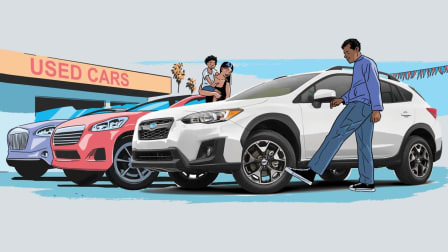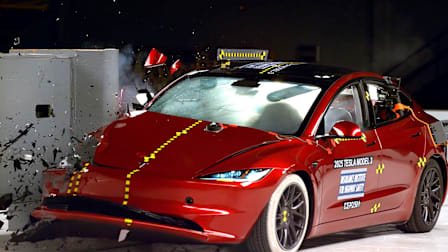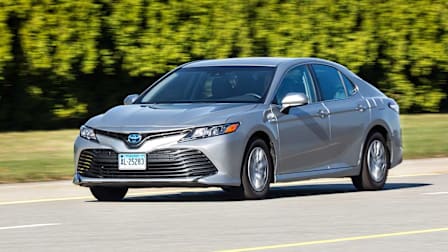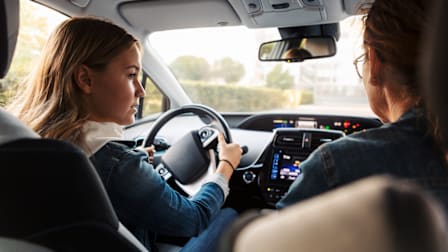Tesla’s New 'Safety Score' Could Lead to Unsafe Driving, a CR Evaluation Shows
The automaker's gamification of safe driving could be an incentive, but Tesla should leverage its other capabilities to judge driver behavior
Within hours of Tesla’s release of its new Safety Score feature, meant to qualify owners for access to the company’s latest version of its Full Self-Driving (FSD) software, some Tesla drivers were discussing on Twitter how they engaged in unsafe driving practices, such as coasting through stop signs or accelerating through yellow lights, to avoid lowering their score from braking too hard.
Kelly Funkhouser, head of automated and connected vehicle testing at Consumer Reports, says that the “gamification” of safe driving is a good idea to pursue but that Tesla’s approach could be having the reverse effect. When we tested the feature in September using our Model Y, we determined that the Safety Score threshold for unsafe hard braking could be exceeded by simply stopping at a stop sign in routine driving. And when we engaged Autopilot, the automaker’s driver assistance feature, and our Model Y approached that same stop sign and applied its brakes, it also exceeded the hard braking threshold. Tesla says that when Autopilot is engaged, the Safety Score is not affected.
Trying to avoid “hard braking” could lead drivers to coast through an intersection or fail to come to a complete stop for a pedestrian, Funkhouser says, adding that Tesla could make some changes to improve how it evaluates drivers in a way that encourages safer driving. “The problem is that Tesla appears to be using some of the wrong metrics,” she says. “Without more context, the data Tesla is collecting and scoring could create bad incentives.”
Tesla says it has internal data showing that the Safety Score improves driver performance. During an investor conference call Oct. 20, Zach Kirkhorn, Tesla’s chief financial officer, said that according to the automaker’s calculations, a driver using the Safety Score has a 30 percent lower probability of a crash than a driver who is not using it.
Careful out there, kids. There is a dangerous new game being played on our city streets. It's called: "Try to get the highest "Tesla Safety Score" without killing anyone." Don't forget to post your highest scores...$TSLA $TSLAQ pic.twitter.com/BvlOjiNwWH
— passthebeano (@passthebeano) September 26, 2021
Very much a beta calculation. It will evolve over time to more accurately predict crash probability.
— Elon Musk (@elonmusk) September 25, 2021
To evaluate the effectiveness of Tesla’s hard braking metric, CR used an accelerometer to determine just how much force 0.3 g—Tesla’s Safety Score threshold for braking—represents in our Model Y. We found that common driving tasks, such as slowing from 25 mph to 0 mph while partially relying on the vehicle’s regenerative braking, would be enough to lower a driver’s Safety Score. CR’s experts note that 0.3 g isn’t a screeching halt with brakes squealing. It’s the kind of stop that most drivers would encounter on most drives.
It wasn’t until the accelerometer measured more than 0.5 g that our test drivers noted that a stop felt like a moderately hard braking event. Those stops were still nowhere near a seat-belt-locking emergency stop, which in our view would be an unsafe threshold.
Gaming the System
At its core, the Safety Score represents two ideas that could bring about positive safety benefits, says Jake Fisher, senior director of CR’s Auto Test Center. It monitors whether drivers are behaving safely on public roads, and it adds gamelike rewards to a relatively boring act like driving to give a motivation to make good choices behind the wheel—a concept known as “gamification.”
Research has shown that gamification can motivate individuals to adopt good habits. For example, a person who wants to get more exercise might respond well to a smartwatch that gives them a “badge” for walking a certain number of steps per day. Automakers often put a real-time fuel-economy monitor on the dashboard to encourage drivers to lay off the gas and conserve fuel. And a German study shows that gamifying safe driving can reduce driver distraction.
But gamification also has a dark side. Researchers at Ohio State University found that when teachers added gamification to the classroom, students were more likely to cheat to win rewards. And it appears that Tesla’s new safe driving metric may be encouraging drivers to find alternative ways of getting a high score, Fisher says.
“Drivers want access to the so-called Full Self-Driving software that they’ve already paid up to $10,000 for, so they may be willing to game the system to get a score that’s good enough,” he says.
Recommended Updates
CR’s safety experts recommend that Tesla take advantage of other information that its vehicles collect in order to gain more context about a driver’s actions. “Tesla vehicles, more than most other cars on the road, can obtain the context of a drive—why a driver hits the brakes, whether a light is about to turn, what road conditions are like—but the Safety Score ignores that,” Funkhouser says.
Tesla is well-positioned to improve the Safety Score so that it encourages safe driving behavior, she says. That’s because Teslas already collect so much data about their surroundings, including what kinds of obstacles a driver is facing and trying to avoid hitting when they rapidly decelerate.
“Hitting the brakes to avoid a cyclist or a pedestrian doesn’t make you a bad driver,” Funkhouser says. Tesla could also pay attention to whether the driver is using the brakes to decelerate or whether the vehicle’s own regenerative braking is responsible for reducing speed.
The score should also take into account whether a driver is speeding, which it currently does not, she says. “The cars can already read speed limit signs, and Autopilot can be programmed to follow the limit, so the car knows how fast the driver should be traveling,” she says. Driving just a few miles per hour over the limit can increase the severity of injuries in a crash, a study from the Insurance Institute for Highway Safety shows.
Ultimately, Fisher says, an update to the Safety Score should also be paired with better driver monitoring. Many Tesla models already have driver-facing cameras that, with the right software, can determine whether a driver is distracted or not looking at the road. Tesla could also determine frequency of cell phone use through its app.
“If Tesla is trying to encourage safe driving, it should focus on whether the driver is paying attention,” Fisher says.
@consumerreports Here's what 0.3 g's in Tesla's driver Safety Score looks like. Learn more at CR.org/TeslaSafetyScore #cartok #cartiktok #teslatok #cars ♬ original sound - Consumer Reports
Editor’s Note: This article, originally published Sept. 27, has been updated to clarify that when Autopilot is engaged, Tesla’s new Safety Score calculations are not affected. It has also been updated to add information shared in Tesla’s Oct. 20 earnings call.

















